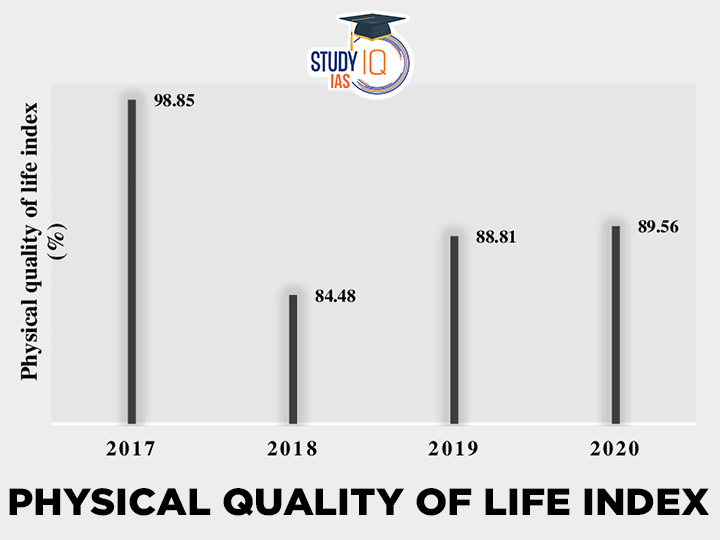Table of Contents
Physical Quality of Life Index
The Physical Quality of Life Index (PQLI) is a measure that combines three basic indicators of human well-being – literacy rate, life expectancy, and infant mortality rate – into a single index. It was developed by Morris David Morris, an American economist, in the late 1970s as an alternative to the Gross Domestic Product (GDP) as a measure of a country’s progress and development.
The PQLI seeks to capture the level of basic human development in a society and compares the well-being of people across different countries and regions.
Read about: GDP of Indian States
Physical Quality of Life Index Components
The Physical Quality of Life Index (PQLI) is an index developed by sociologist Morris David Morris that measures the quality of life in a country or region based on three basic components:
| Components of PQLI | Indicator |
| Life expectancy | The number of years a newborn can expect to live, on average |
| Infant mortality rate | The number of infants who die before reaching the age of one, per 1,000 live births |
| Literacy rate | The percentage of people aged 15 and above who can read and write |
These three indicators are combined to create the Physical Quality of Life Index (PQLI), which provides a comprehensive measure of basic human well-being in a society. The PQLI ranges from 0 to 100, with higher scores indicating better quality of life. The PQLI is often used as an alternative to GDP as a measure of development, as it captures aspects of human well-being that are not captured by economic measures alone.
Read about: GDP Deflator
Physical Quality of Life Index Limitations
While the Physical Quality of Life Index (PQLI) provides a comprehensive measure of basic human well-being, it has several limitations, which include:
Limited Scope
The PQLI only captures three basic indicators of well-being – life expectancy, infant mortality rate, and literacy rate – and does not include other important aspects such as access to healthcare, education quality, income, and standard of living.
Lack of Cultural Sensitivity
The PQLI is a one-size-fits-all approach that does not take into account cultural differences and variations in lifestyle and social norms that can affect the well-being of people in different societies.
Inadequate Data
The PQLI relies on data that may not be accurate or up-to-date, particularly in low-income countries where data collection systems may be weak.
Lack of Weightage
The PQLI treats all three indicators as equally important and does not provide any weightage to indicate which of the three is more critical for well-being in a particular society.
Biases
The PQLI is based on the assumption that higher literacy rates, longer life expectancies, and lower infant mortality rates are always indicative of a better quality of life, which may not always be true.
Overall, while the PQLI can provide a useful snapshot of basic human well-being, it should be used with caution, and in conjunction with other measures of development and well-being.
Read about: Basel Norms
Physical Quality of Life Index UPSC
The Physical Quality of Life Index (PQLI) is an important topic for UPSC as it is a measure of basic human well-being and is relevant to topics in the UPSC Syllabus such as Human Development, Social Justice, and Poverty Alleviation. Understanding the components, limitations, and significance of PQLI can help aspirants prepare for UPSC Online Coaching and UPSC Mock Test related to these topics.
Read More: Types of Inflation


 Goods and Services Tax (GST), Objectives...
Goods and Services Tax (GST), Objectives...
 World Oceans Day 2025, History, Theme, S...
World Oceans Day 2025, History, Theme, S...
 World Environment Day 2025, Theme, Histo...
World Environment Day 2025, Theme, Histo...





















